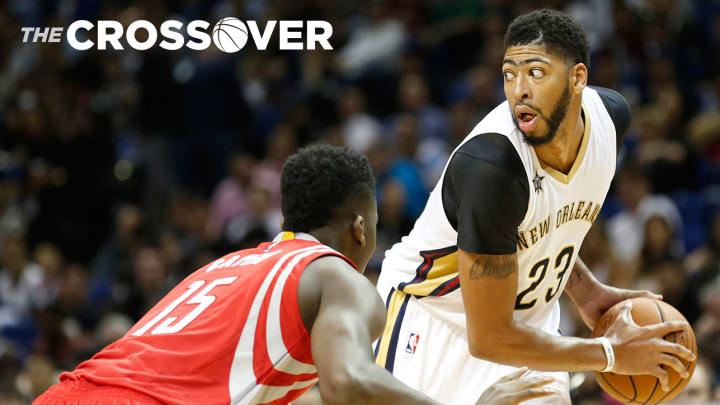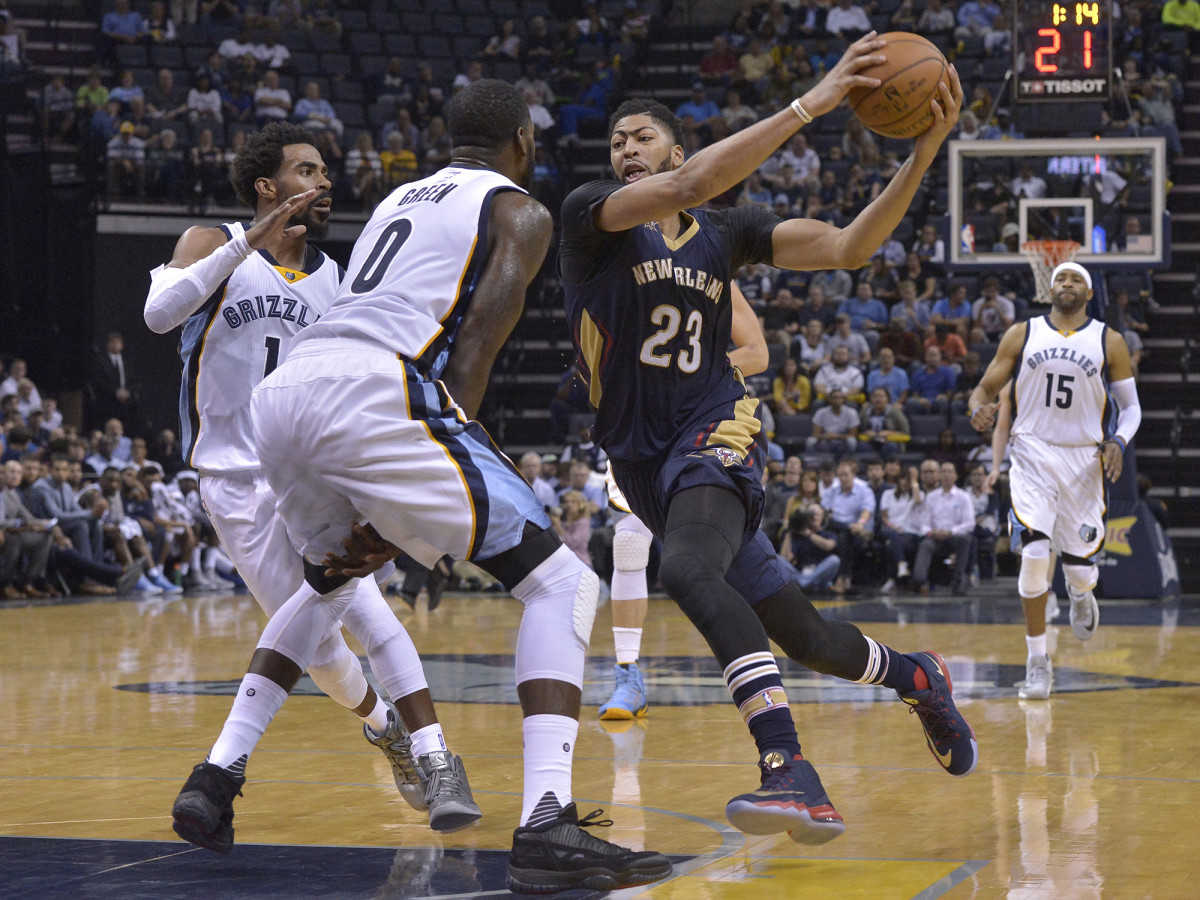Mission Impossible: Defending Anthony Davis Is A Terrifying Proposition

Anthony Davis, in a twisted sense, is playing career-best basketball as a product of his dispiriting circumstances. None of Davis's fellow superstars—save, perhaps, for DeMarcus Cousins—does so much with so little structural support. It's telling that the smallest bit of help from Jrue Holiday, Terrence Jones, or E'Twaun Moore goes such a long way. New Orleans has quality players here and there but lacks for consistent, winning combinations. Holiday, who is playing as well as one can under a minutes limit, is the closest the team has to a second star. Tim Frazier, a stopgap point guard on a bargain salary, is the next-best creative option.
All of which leaves Davis to deal with multiple chaperones whenever he'd like to go to work. Pelican opponents are incentivized to load up on the NBA's leading scorer with as many defenders as is necessary. Test the squad ranking 26th in the league in three-point percentage to move the ball and hit their shots. Encourage Jones and Dante Cunningham to make plays on the move. And when in doubt, channel the offense in a way that forces Omer Asik to catch and finish in traffic. Most any outcome is better than Davis getting his, though the 23-year-old has shown an ability to take that decision out of the defense's hands entirely.
Will this be the year Anthony Davis saves the Pelicans?
The Davis of today is a nullifier—he stays patient in the face of multiple defenders, he shoots over the top, and he attacks in a way that isolates the coverage in front of him. A tighter, more comfortable handle opens up his options. Davis is hitting big-man defenders with crossovers and hesitation moves that force them to backpedal as if he were a waterbug guard. The trap lies in the fact that he's actually a deadeye shooter with such a high release point that conservative coverage means little. If the defense isn't on top of Davis, he's launching up a jumper with little regard for how many smaller, overmatched defenders are standing a few feet away. Davis seems more acutely aware of this dynamic than ever, and is mining roughly as much scoring from the pull-up game as Paul George and Gordon Hayward, according to NBA.com.
Davis is long since established as one of the league's best-shooting bigs, but this season he's taken the next step as sort of a wing-big hybrid. New Orleans posts Davis, activates him in pick-and-roll, and allows him to isolate plenty. It also features sets that have Davis curl around multiple, staggered screens for a quick catch-and-shoot, positioning his shooting utility somewhere between Dirk Nowitzki and Klay Thompson.
The Pelicans have also been smart about trying to establish Davis in the triple threat at the top of the floor within their offense, a placement which makes any overt double team more dicey. Pressure works best when opposite an inherent boundary; there's a reason why the best halfcourt traps constrict a ball-handler to the corner and the tightest pick-and-roll coverages tend to use the sidelines to their advantage. Doubling without that backstop leaves Davis, maybe the most mobile big in the game, too elusive. He can slip between defenders into the lane or explore his options out on the perimeter too easily.

All Davis has to do to beat a potential double team is create the slightest separation among his two defenders. Sometimes this is as easy as pivoting between them, allowing Davis to split the coverage before he even puts the ball on the floor. A jab step just as the second, doubling defender closes in can also send the entire enterprise into disarray; opponents are so understandably fearful of Davis's speed that they tend to overreact to his every feint. If nothing else, Davis is big and quick enough to simply drive end around in some cases, piling up his defenders and limiting what they can accomplish.
Often Davis attacks so quickly and initiates his upward motion so far from the hoop—one of the perks of being a skilled and fluid near-seven-footer—that making a full defensive rotation seems impossible. Davis has attempted 364 shots so far this season. Only eight of them have been blocked, per NBA Miner. Defenders bold enough to launch themselves upward to meet Davis at the rim are far more likely to commit a foul than do anything legitimately preventative. And even then, Davis has converted more shots through the foul this season than all but Cousins. Nothing speaks to the defense's futility quite like one of the most oft-crowded scorers in basketball getting to the free throw line nearly 11 times a game and converting at least one and-one, on average, every night.
That ability to absorb contact is a credit to his fortified body and an added frustration for opposing bigs everywhere. As recently as last season, it was easy for Davis to fall into lulls by complacently shooting the first jumper that came available. The threat of that shot remains but its value has been punctuated with greater variety. Even multiple defenders are kept on edge by the fact that they can't totally contain Davis off the dribble, nor have much hope at all of contesting his runners, hooks, and turnaround jumpers. Those shots, when swarmed as Davis often is, can be some of the most difficult shots in the game. Success in the intermediate range requires just the sort of soft touch and delicate balance that can be disrupted by having multiple defenders lingering about. None of it much fazes Davis, who has made an astonishing 60.6% of his shots between 3–10 feet this season, per Basketball-Reference. Teams can pack the lane all they want, body up Davis as much as they can, and still surrender an untenably efficient shot in the end.
Davis has never come anywhere close to converting from that range at that clip, so consider his specific shooting performance rubber stamped with your standard warnings of sample size. Yet in the case of a player like Davis—who is just in his fifth season and still years away from his playing prime—it's not crazy to think that his game might undergo some transformational progress along the way. The wonder of watching Davis to this point stemmed from the fact that his ceiling was never fully in view. There was always somewhere further his game could grow within the range of what his tools and emerging skills would plausibly allow.
Consider this a glimpse of that future, and of what terrifying realities await the rest of the league when doubling Davis so consistently is no longer a viable option.
